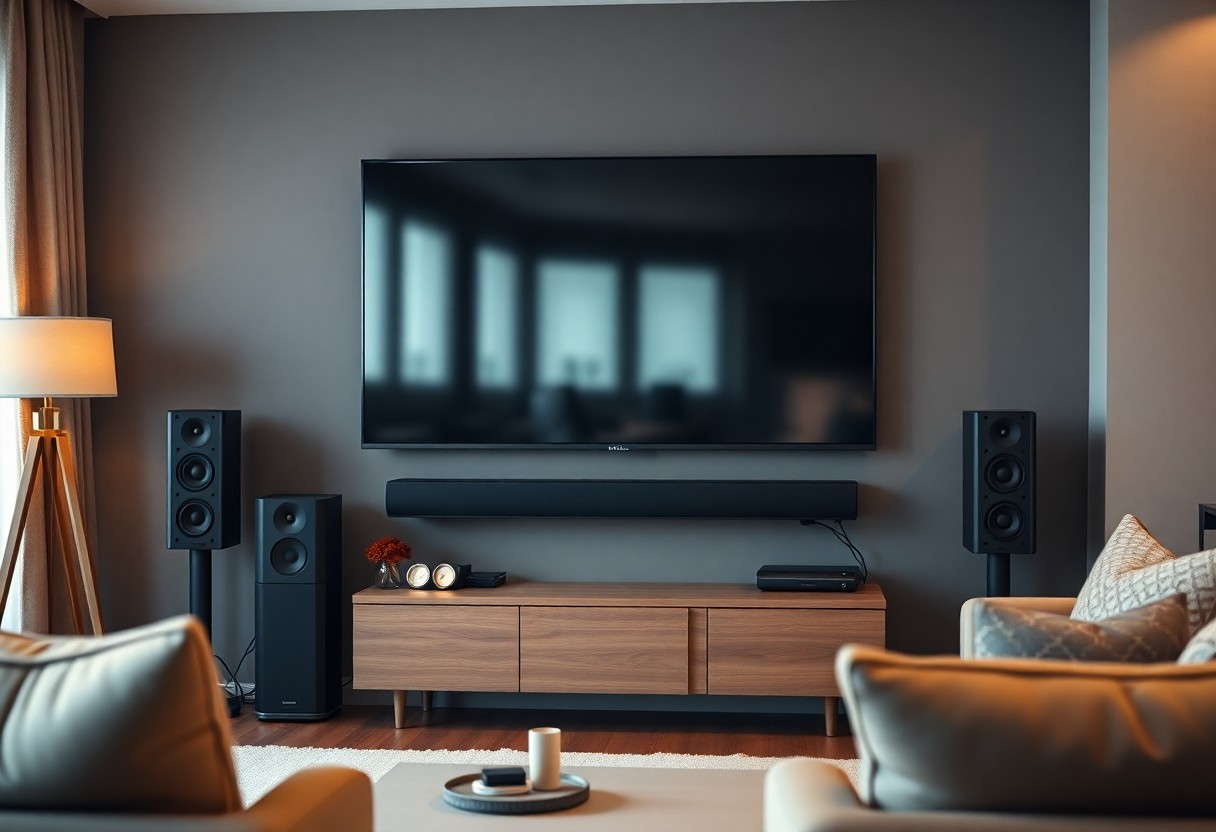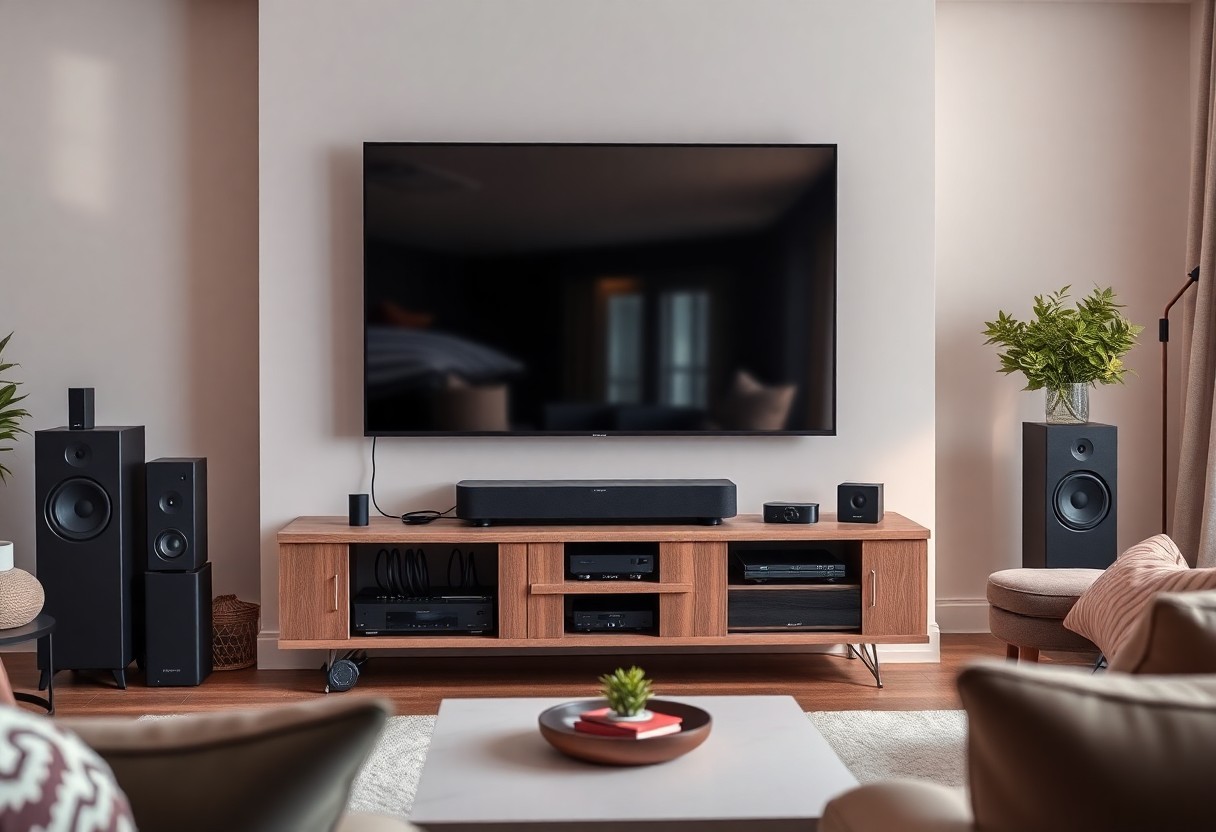Over the years, soundbars have become a popular solution for enhancing your home audio experience, but setting one up for optimal performance may seem daunting. In this guide, you’ll discover necessary tips and tricks to ensure your soundbar delivers the best audio quality possible. Whether you’re a movie enthusiast or a music lover, you’ll learn how to position, connect, and configure your soundbar to transform your listening experience. Let’s investigate the world of sound, so you can enjoy every note and sound effect to its fullest!
Contents
Understanding Your Soundbar
Your soundbar is an necessary component of your home audio system, designed to enhance your viewing experience with high-quality sound. Understanding its structure and capabilities is key to maximizing its performance. A soundbar typically includes multiple speakers, built-in amplifiers, and various connectivity options, all working together to deliver an immersive audio experience. By familiarizing yourself with its specifications, you can make informed adjustments to ensure optimal sound quality in your space.
Choosing the Right Soundbar
Assuming you want to elevate your audio experience, selecting the right soundbar is your first step. Consider the size of your room, the type of content you consume, and your budget. It’s important to choose a soundbar that complements your television and suits your listening preferences—whether that’s crisp dialogue for movies or deep bass for music. With so many options available, making an informed decision can greatly enhance your overall audio experience.
Essential Features to Look For
Soundbar features greatly impact its performance and usability. Look for options that enhance your audio experience, such as Bluetooth connectivity, HDMI ARC support, and surround sound capabilities. Additional features like built-in voice assistants and customizable sound modes can further enhance your interaction with the soundbar, allowing you to tailor the audio output to your liking. Certain models may also include a wireless subwoofer, which can significantly improve bass response, making your listening experience even more dynamic.
A variety of necessary features can help boost your soundbar’s performance. Look for models that support Dolby Atmos or DTS:X for immersive surround sound and check if they have multiple audio modes for different types of content, such as movies, sports, and music. Connectivity options play a significant role too; ensure your soundbar has HDMI ports, optical input, and Bluetooth, allowing you to effortlessly connect it to other devices. An integrated subwoofer might also enhance the low frequencies, giving your music and movies a richer depth. Ultimately, selecting a soundbar with the right features will bring your audio experience to the next level.
Placement Tips for Optimal Sound
It’s important to position your soundbar effectively to enhance audio quality. Consider these tips for optimal placement:
- Place the soundbar at ear level when seated.
- Keep it centered below or above your TV.
- Avoid placing it in a cabinet; instead, use an open shelf.
- Angle the soundbar towards your seating area.
Any adjustments can significantly improve your listening experience, especially when you explore Optimized Settings for Vizio Dolby Atmos Soundbar ….
Ideal Positioning in the Room
Some positioning strategies can make a remarkable difference in sound quality. Ensure your soundbar is located at the right height, typically either mounted on the wall or resting on a surface that aligns with your ear level when seated. By centering it below or above your television, you create a more immersive audio experience.
Avoiding Sound Obstacles
Sound quality can be hindered by various obstacles in your environment. To achieve optimal audio performance, keep your soundbar clear of furniture, decorative elements, and electronics that might muffle the sound. Any items in the path between the soundbar and your seating area can distort the clarity and richness of the audio output. To ensure a seamless sound experience, maintain an open and unobstructed line of sight.
Room acoustics also play an important role in sound quality. Hard surfaces like tile or glass can lead to echo, while soft furnishings can absorb sound, creating an imbalance. Experiment with positioning your soundbar in different areas of the room and listen for changes in audio clarity and depth. Additionally, minimizing clutter around the soundbar allows for a clearer path for sound waves, which ultimately gives you a more immersive listening experience.
Connecting Your Soundbar
Now that you’ve selected the perfect soundbar, it’s time to connect it for optimal audio performance. Ensure you have the necessary cables and setup tools ready. Depending on your home theater system, you may have several connection options to choose from, ensuring the best possible integration with your existing devices.
Wired vs. Wireless Connections
For choosing between wired and wireless connections, consider your preferences for convenience and sound quality. Wired connections typically provide a more stable and higher quality audio experience, while wireless options offer flexibility without the clutter of cables. Assess your space and determine which method best suits your setup.
Setting Up HDMI ARC
Little do many know, HDMI ARC (Audio Return Channel) significantly simplifies your sound system by allowing audio to travel both ways along the HDMI cable. This means you can control your soundbar and TV with a single remote, streamlining your audio experience.
A proper HDMI ARC setup enhances your overall viewing experience, allowing for high-quality sound without multiple remotes. To establish this connection, make sure your soundbar and TV both support the HDMI ARC feature. Connect the soundbar to your TV’s ARC-enabled HDMI port, usually labeled on the back of your TV. Enable ARC in your TV and soundbar settings, and enjoy seamless audio playback from various devices, ensuring every cinematic moment is truly immersive.

Adjusting Audio Settings
Unlike simply connecting your soundbar and hoping for the best, adjusting the audio settings can significantly enhance your listening experience. Take the time to explore your soundbar’s various settings, as these allow you to customize sound profiles based on your room’s acoustics and your personal preferences. Experimenting with these settings ensures that your soundbar provides the best audio quality tailored specifically to your environment.
Sound Modes and Equalization
Equalization is a powerful tool that lets you adjust the frequencies of different audio elements for a more balanced sound. Many soundbars come with preset sound modes designed for specific types of content, such as movies, music, or gaming. By selecting the mode that best fits what you’re watching or listening to, you can enhance clarity and immersive experience. Additionally, fine-tuning the EQ settings can help you address any specific frequency ranges that might be too pronounced or lacking.
Balancing Volume Levels
Sound quality is not solely determined by clarity; balancing volume levels across different audio sources is necessary for an enjoyable experience. You may find that movies, music, or gaming vary in volume, making it difficult to maintain a consistent listening level.
Another effective approach is to utilize any audio normalization features available on your soundbar. These settings can equalize volume levels between different channels and sources, ensuring that sudden loud sounds do not startle you, while also preventing softer audio from being drowned out. This balance not only complements your overall audio experience but also engages you more fully in the content you’re enjoying.
Enhancing Audio with Additional Devices
Keep in mind that your soundbar can reach new audio heights when paired with additional devices. By integrating a subwoofer and surround sound systems, you can achieve a more immersive and fuller sound experience. This not only enhances your home cinema but also elevates your overall listening experience whether you’re watching movies or enjoying music.
Integrating Subwoofers
Enhancing your audio experience is easily achieved by integrating a subwoofer into your soundbar setup. A subwoofer delivers deep bass tones that add depth and richness to your audio, helping to replicate the powerful sounds found in action-packed movies or your favorite songs. By connecting a subwoofer to your soundbar, you create a more balanced sound profile that brings every sound to life.
Using Surround Sound Systems
While integrating additional audio components into your setup, a surround sound system can take your sound experience to the next level. Surround sound setups create an immersive audio environment by placing speakers around your room, allowing you to hear sounds from multiple directions. This greatly enhances the cinematic experience, making you feel as though you’re right in the middle of the action.
The key to a fantastic home theater setup is ensuring that your soundbar and surround sound speakers work harmoniously together. Positioning speakers at appropriate angles and distances can amplify the sound dynamics, allowing you to experience every detail in the audio mix. Whether you’re gaming, watching movies, or hosting a gathering, a well-integrated surround sound system will provide an unforgettable audio experience.

Common Troubleshooting Tips
Despite setting up your soundbar perfectly, you might encounter some sound issues. Here are a few quick tips to help you troubleshoot effectively:
- Ensure all cables are securely connected.
- Check that the soundbar is set to the correct input source.
- Adjust the audio settings on your TV or device.
- Power cycle your soundbar and connected devices.
Recognizing these common issues can save you frustration when enjoying your audio experience.
Resolving Audio Sync Issues
With the significance of timing in audio-visual experiences, audio sync issues can be annoying. To resolve these, access your soundbar’s settings and look for options like “lip-sync,” “audio delay,” or “AV sync,” adjusting them until the audio aligns with the video. Additionally, check your TV’s settings for similar options to help harmonize audio and visual outputs.
Fixing Connectivity Problems
Resolving connectivity issues is important for a seamless sound experience. Start by checking the Bluetooth or HDMI connections, ensuring they are properly paired and plugged in. Also, look for any interference from other devices and consider moving the soundbar closer to the source. If you’re using Wi-Fi, ensure your network is stable and your soundbar firmware is up to date.
A stable connection usually requires a few adjustments. If wireless connections are problematic, try switching to wired connections using the optical or AUX cable for direct access. Additionally, ensure that your devices are compatible with the soundbar’s connectivity options. Regularly updating the firmware can also enhance performance and address any bugs affecting connectivity, ensuring that your audio setup continues to function optimally.
Conclusion
To wrap up, optimizing your soundbar for the best audio quality involves a few key steps, including the right placement, connecting to your TV properly, and adjusting the settings to fit your room acoustics. By following these tips and tricks, you can significantly enhance your listening experience, making it more immersive and enjoyable. Don’t hesitate to experiment with different configurations to find what works best for your environment—your soundbar has the potential to transform your audio experience.

Leave a Reply